Paying it
forward: NMP mobilizes donation drive for MPCF
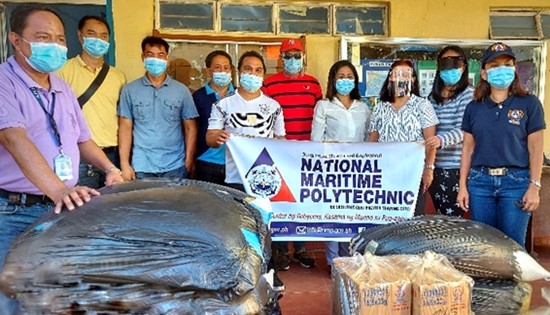
By
National Maritime Polytechnic
November 25, 2020
TACLOBAN CITY –
Humbled by the Super-typhoon Yolanda experience in November 2013,
the National Maritime Polytechnic (NMP) rolled out a donation drive
for the victims of Super-typhoon Rolly in Bicol region, particularly
to the employees, staff, and students of the Mariners Polytechnic
Colleges Foundation (MPCF) - Legaspi and Naga Campuses. A special
committee for the said undertaking was created, chaired by the NMP
Deputy Executive Director, Ms. Mayla N. Macadawan.
“It is our time now to
give back to the MPCF who wholeheartedly helped NMP recover and
rebuild after the onslaught of Super-typhoon Yolanda. In the spirit
of unity, we need to help them, no matter how small, to reciprocate
the kindness they extended to NMP during the difficult and
challenging days of Yolanda, besides, no act of kindness is too
small”, said NMP Executive Director Joel B. Maglunsod.
It can be recalled that on
26 November 2013, roughly eighteen (18) days after Yolanda,
Commodore Dante L Jimenez, the then President and CEO of the MPCF,
visited NMP and upon seeing the damages wrought by the typhoon,
volunteered in mobilizing assistance from the private maritime
sector including the Philippine Association of Maritime Training
Center, Inc. (PAMTCI) and other maritime associations.
The MPCF deployed four (4)
batches of its National Service Training Program (NSTP) cadets to
NMP from December 2013 to March 2014 for the much-needed clearing
and cleaning operations. Relief goods consisting of food packs and
used clothing were also distributed to NMP employees, job order
workers, and security guards.
NMP knows how it feels
after being devastated by a super-typhoon, life was grey and dreary.
However, everything had to be recovered including the broken spirits
of the people affected, thus, the donation drive was pushed to
convey the NMP’s heartfelt appreciation to the overwhelming support
of the MPCF who laboriously helped the Agency to rise above the
shackles of uncertainties brought by Yolanda.
Through the concerted
efforts of the NMP management and staff, the Agency’s sole and
exclusive negotiating agent, the NMP Services Association (NMPSA),
and the Philippine Coast Guard - Coast Guard District Eastern
Visayas (CGDEV), the relief assistance was successfully turned -over
to the MPCF on 21 November 2020.
“We are very much glad and
thankful for the assistance of NMP and for its effort of personally
coming to our place to hand-over the heartwarming donations for the
victims of Typhoon Rolly”, relayed by Ms. Ahmie Lanuzo, Community
Extension Service Director of MPCF.
NMP will forever be
grateful to everyone who in one way or another helped the Agency to
rise again after the devastation of Yolanda, repositioning NMP for a
higher rebound in maritime training and research.
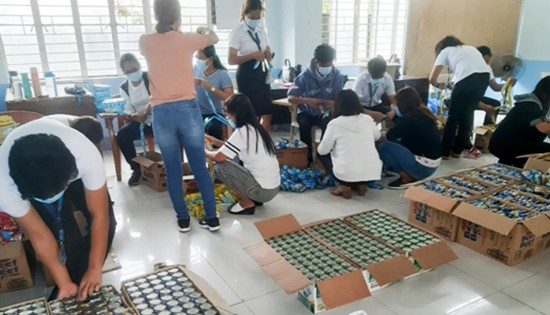
Eastern Visayas’
economy slows down to 5.3% in 2019
By
PSA-8
November 24, 2020
TACLOBAN CITY – The
economy of Eastern Visayas grew by 5.3 percent in 2019, albeit,
slower than the 7.0 percent growth recorded in 2018. The economic
growth in 2019 was driven by the Financial and Insurance Activities
(FIA), Education, Manufacturing, Wholesale and Retail Trade; Repair
of Motor Vehicles and Motorcycles, and Electricity, Steam, Water
Supply and Waste Management (ESWW).
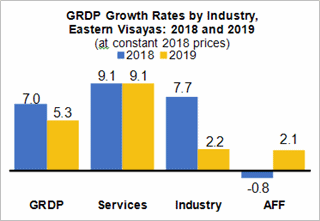 Services sustained its 9.1
percent growth in 2019. Among its sub-industries, Financial and
Insurance Activities (FIA), as well as Information and Communication
(IAC) posted accelerated growths at 19.3 percent from 12.1 percent,
and 11.0 percent from 7.2 percent, respectively. Public
Administration and Defense; Compulsory Social Security (PAD)
sustained its 14.1 percent growth in 2019.
Services sustained its 9.1
percent growth in 2019. Among its sub-industries, Financial and
Insurance Activities (FIA), as well as Information and Communication
(IAC) posted accelerated growths at 19.3 percent from 12.1 percent,
and 11.0 percent from 7.2 percent, respectively. Public
Administration and Defense; Compulsory Social Security (PAD)
sustained its 14.1 percent growth in 2019.
Other sub-industries grew
at a slower pace: Wholesale and Retail Trade; Repair of Motor
Vehicles and motorcycles slowed down to 6.0 percent from 7.6
percent; Transportation and Storage decelerated to 5.3 percent from
12.7 percent; Accommodation and Food Service Activities (AFSA)
decelerated to 1.8 percent from 19.9 percent; Real Estate and
Ownership of Dwellings (REOD) slowed down to 3.0 percent from 6.1
percent.
Professional and Business
Services (PBS) decelerated to 4.0 percent from 4.9 percent;
Education decelerated to 13.5 percent from 14.2 percent. Meanwhile,
Other Services (OS) rebounded from 4.0 percent contraction in 2018
to 16.2 percent growth in 2019. Human Health and Social Work
Activities (HHSWA) continued to decline at a slower rate to 0.7
percent in 2019 from 7.3 percent contraction in 2018.
Industry decelerated to
2.2 percent in 2019 from 7.7 percent in 2018. Electricity, Steam,
Water Supply and Waste Management slowed down to 7.1 percent from
7.4 percent. Manufacturing recovered from 6.6 percent contraction in
2018 to 6.0 percent growth in 2019. Meanwhile, Mining and Quarrying
(MAQ), and Construction contracted to 6.0 percent and 1.8 percent in
2019, respectively.
Meanwhile, Agriculture,
Forestry and Fishing (AFF) recovered from 0.8 percent contraction in
2018 to 2.1 percent growth in 2019.
Services and Industry
shared the bulk of the region’s economy at 46.8 percent and 39.7
percent, respectively. AFF had a share of 13.5 percent.
Among the three (3) major
industries, Services contributed most to the region’s overall growth
rate at 4.1 percentage points. Industry shared 0.9 percentage point,
followed by Agriculture, Forestry and Fishing at 0.3 percentage
point.
Puentespina Farms
opens doors to DavOr’s cacao farmers, coops
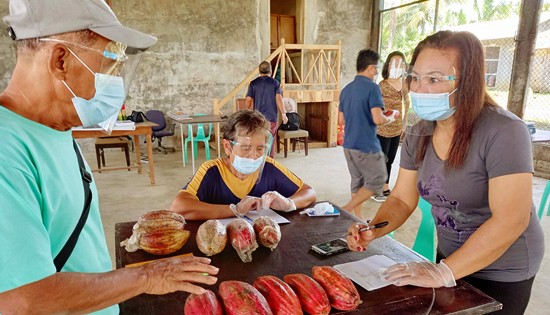
By
DTI-Regional Operations
Group
November 24, 2020
DAVAO CITY – The
Department of Trade and Industry (DTI) Rural Agro-enterprise
Partnership for Inclusive Development and Growth (RAPID Growth)
Project, in partnership with the Puentespina Farms, conducted a
five-day intensive training on cacao processing, bean trading, and
cacao economics among the seven cacao farmer organizations from
Davao Oriental on November 16 to20.
The Puentespina Farms,
through its Malagos Cacao Development Center (MCDC), which is the
birth place of the award-winning Malagos Chocolate, shared its
processing technology, standards and protocols that brought them to
the world stage. The participants, composed of twelve farmers,
underwent several activities to hone their skills further. These
included those on understanding the Philippine cacao genetics and
opportunities, productivity enhancement, fermentation and drying
process, bean grading and cacao economics, such as product costing.
Furthermore, the cacao farmers and coop leaders had an actual field
demonstration on all the topics to ensure that they acquired the
necessary knowledge and skills related to technology and the science
behind cacao production and processing.
In the meantime, the
participants also received an orientation on Good Agricultural
Practices (GAP) and process requirements from the Department of
Agriculture (DA) Regulatory Division, as part of the project’s
package of assistance. Likewise, the Philippine Crop Insurance
Corporation (PCIC) gave an orientation of its services, as well as,
encouraged these farmers and micro, small and medium enterprises (MSMEs)
to avail of the government’s subsidized insurance intervention.
The seven farmer
organizations that participated in the latest activities were the
Nagkahiusang Mag-uuma sa San Isidro (NAGMASID ARCO), Davao Oriental
Coco & Cacao Development Coalition (DOCCIDeC), Limot Tribal Mandaya
Coop (LIMTRIMCO), Gov. Generoso Cacao Farmers (GGCFA), Panikian
Cacao Sustainable Farmers (PACSFA), NAKMACCO and Yagakauyon ng
Kooperatiba ng San Ignacio (YAKOSI). They would cascade these
learnings to their respective members. These groups are
beneficiaries of DA’s Philippine Rural Development Program’s (PRDP)
cacao post-harvest facilities. As such, the DTI-RAPID Growth Project
complements the other government agencies’ interventions and
harmonizes the support to ensure that the proposed business model
will be carried out and sustained.
The MCDC shared the same
vision with the DTI - RAPID Growth Project, which is to build and
sustain a solid supply of raw materials. Thus, it commits to help in
the production of high quality cacao beans, while strengthening the
foundation of cacao farming. Along this line, the company will enter
into a marketing agreement with the farmer organizations. Part of
the said partnership are the continuous technical interventions of
MCDC, particularly the Puentespina Farms. Being the anchor firm, it
would help establish the business enterprise systems and protocols
of the backward links. This partnership with MCDC is expected to
benefit around 300 to 350 cacao farmers, by having an institutional
market for high quality beans.
Puentespina Farms owner
Charita Puentespina encouraged the farmer leaders to share the
knowledge they acquired to their members and to really nurture their
most vital capital - the cacao variety in the Philippines.
“If there’s proper
technology transfer, the farmers could get a premium price for their
produce, since they are targeting to provide and offer fine cacao
both to the local and international markets,” Puentespina said.
To achieve the
collaboration’s objective, all parties agreed to continuously work
together to finalize their commercial partnership agreement. This
would include the operation systems and protocols and the roles and
responsibilities of each of them to strengthen and sustain the
partnership.
The DTI- RAPID Growth
Project is a special initiative, which DTI implements, and with a
funding support from the International Fund for Agriculture
Development (IFAD). It focuses on four industries - cacao, coffee,
coconut and processed fruits and nuts.
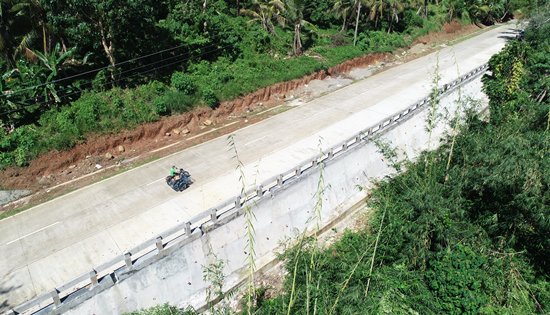
Completed
construction of road slope protection in Brgy.
Tomalistis, Caibiran, Biliran. |
DPWH-Biliran DEO
completes P35.7M road slope protection in Caibiran, Biliran
Press Release
November 23, 2020
NAVAL, Biliran –
Motorists are now enjoying a wider and safer travel along Tomalistis
Road in the town of Caibiran as the Department of Public Works and
Highways (DPWH)- Biliran District Engineering Office completes the
P35.7M road slope protection project.
According to David P.
Adongay Jr., District Engineer, the construction of road slope
protection was implemented in three road sections at Tomalistis road
along Biliran Circumferential Road (BCR) where road slips and
landslides are most likely to occur.
The said project entails
the construction of 2,002.87 square meters of road slope protection
(gravity wall) (left side) including re-blocking and paving of
shoulder.
The District Engineer said
that the completion of the said project will prevent further road
slips and landslides along this road section at BCR, thereby
protecting the existing national road from future damage.
“Road closures because of
road slips and landslides causes inconvenience to the travelling
public, the completion of this road slope protection will ensure
that motorists can always have an alternative route along BCR when
other road sections will be closed to traffic,” Adongay said.
Moreover, the road slope
protection project will preserve the existing concrete road
subjected to wear and tear of heavy equipment and vehicles. This
will earn the government savings in rehabilitating damaged pavement
in the future caused by slips and soil collapse.
|
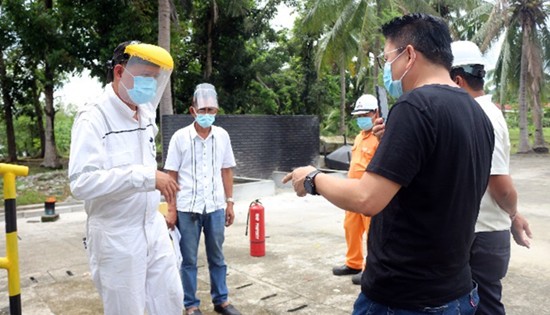
MARINA
Representative, Engr. Jose Romualdo Denzon, conducting
on-site inspection for AFF and RAFF training courses on
October 21, 2020. |
NMP courses pass
MARINA accreditation
By
National Maritime Polytechnic
November 20, 2020
TACLOBAN CITY – The
National Maritime Polytechnic’s (NMP) application for
reaccreditation of its two (2) Standards of Training, Certification,
and Watchkeeping for Seafarers (STCW) courses, namely: Advanced Fire
Fighting (AFF) and Refresher Course on Advanced Fire Fighting (RAFF)
have been approved by the Maritime Industry Authority (MARINA).
In the official letter
issued by MARINA dated 30 October 2020, which was received by NMP on
05 November 2020, the aforementioned STCW courses were granted full
course approval valid for three (3) years effective upon payment of
course approval fees. However, the 3-year validity period of RAFF
will commence from the grant of its Provisional Authority to conduct
the said training on 01 July 2019.
Alongside with the
approval of the said courses, MARINA also accredited the NMP’s
instructors, assessors and supervisors who will be handling the
above-mentioned courses.
During the 3-year period,
announced and unannounced visits will be made by MARINA STCW Office
or its duly authorized representatives to ascertain NMP’s compliance
with the MARINA’s rules and regulations.
Moreover, the records of
implementation of corrective actions for audit results both internal
and external, records of review and validation of the courses
including the assessment and statistical record of trainees enrolled
/ certificated must be made available during the conduct of
monitoring.
NMP Executive Director
Joel B. Maglunsod expressed his appreciation to MARINA for granting
the full course approval of the Agency’s ten (10) STCW courses
within the year.
“We are thankful for the
support and guidance that the MARINA has continuously extended to
NMP throughout our journey in putting our STCW courses in place
which paved way to the accreditation of our ten (10) STCW courses
which took us over two (2) years of working out”, said ED Maglunsod.
It can be recalled that
NMP applied for reaccreditation of its ten (10) STCW courses in
January 2018. The full course approval of each course was issued in
a staggered basis pending the compliance with the requirements set
forth under MARINA STCW Advisory No. 2019-05 re: Clarifications and
Supplemental Guidelines on the Implementation of STCW Circular No.
2018-02 entitled “Standards for Mandatory Training Courses Under the
STCW Convention, 1978, as Amended” and the results of the site
inspections conducted last 24-28 February and 21 October this year.
The aforementioned courses
are now open for enrollment. Interested enrollees may call the NMP
Registrar’s Office at the following contact numbers: 0965-182-3521 /
0939-006-3780 or the Information Marketing Section (IMS) through
cellphone no. 0936-786-2196 or email us at info@nmp.gov.ph. They may
also visit the NMP website @ www.nmp.gov.ph or the agency’s Facebook
page (www.facebook.com/ nmptrainingcenter) where all updates and
relevant information on NMP programs are available.
Meanwhile, NMP continues
to conduct face-to-face trainings with strict implementation of the
Maritime Industry Authority’s (MARINA) approved Post-Enhanced
Community Quarantine Operational Plan and other health and safety
protocols as required by the Department of Health (DOH), Department
of Labor and Employment (DOLE), and local government unit (LGU).
Likewise, Filipino
seafarers who are interested to avail of the NMP’s FREE online
classes on SHAPIMS, PADAMS, and GSTS may register through this link:
https://nmp.gov.ph/online-course-offerings/.
Interested stakeholders
who wish to validate the authenticity of their seafarers-employed
with NMP issued certificates may visit www.verify.nmp.gov.ph.
Likewise, those interested in NMP research undertakings may visit
the NMP website and access the e-Research Information System Portal
which is designed to disseminate NMP completed researches, present
the Research Agenda, and engage the industry stakeholders to
collaborate in the research activities.
Further, NMP encourages
OWWA registered seafarers to avail of the NMP-OWWA (Overseas Workers
Welfare Administration) Seafarers’ Upgrading Program (SUP) and
Skills for Employment Scholarship Program (SESP) which entitles the
beneficiary to receive financial assistance for training costs from
the OWWA.
Road leading to
Mapaso Hot Spring undertaken

By
GISSELLE G. PARUNGAO
November 19, 2020
CALBAYOG CITY – An
access road leading to Mapaso Hot Spring is currently undertaken by
the Department of Public Works Highways- Samar First District
Engineering Office.
This road taps from an
existing road that leads to Maharlika Highway and will lead to one
of the leading tourist destinations in Calbayog City, the Mapaso Hot
Spring. This is drawn from the General Appropriations Act (GAA) 2020
with a total allocation of P30 million.
Calbayog City is
well-endowed with natural resources and potential tourist magnets.
Mapaso Hot Spring is one of the main tourist attractions of Calbayog
City, well-known for its soothing and refreshing pools of hot water.
Bordered by mountain glades and rich vegetation, the place is as
remote as it gets.
There are two ways that
this destination can be reached. One way is through Oquendo
Poblacion where you would have to take a boat to cross a river (Oquendo
River) going to the hot spring which will take 30 minutes.
Another way is to go
through Barangay Amampacang then to Dinagan, Mabini and finally in
Barangay Rizal II which is roughly 6.6 kilometers with a vehicle.
Calbayog City is a
fast-growing commercial hub. With its boom comes the need for bigger
and better thoroughfares to accommodate the increasing traffic
volume and influx of tourists that may visit the tourist
destination.
Samar agrarian
reform beneficiaries organization wins DOST award
By
JOSE ALSMITH L. SORIA
November 19, 2020
JIABONG, Samar –
The operationalization of a common service facility by a pop rice
producer-agrarian reform beneficiaries organization (ARBO) based in
this fifth class municipality was recognized on Friday by the
Department of Science and Technology (DOST) as this year’s best
Grant-in-Aid (GIA) science and technology project implemented in
Eastern Visayas.
 Cantongtong Agrarian Rice
Farmers Association (CARFA) bested five other contenders coming from
the five other provinces in the region and received P5,000 cash
prize.
Cantongtong Agrarian Rice
Farmers Association (CARFA) bested five other contenders coming from
the five other provinces in the region and received P5,000 cash
prize.
This was announced during
the virtual culmination activity of the weeklong celebration of
DOST-8’s National Science and Technology Week held on November 9-13,
with this year’s theme, “Agham at Teknolohiya: Sandigan ng Kabuhayan,
Kaayusan at Kinabukasan".
OIC-Regional Director
Ismael Aya-ay of the Department of Agrarian Reform (DAR) sent his
congratulatory message to CARFA for the honors they are reaping now.
Aya-ay is happy to know that CARFA is taking advantage of the all
the assistance and opportunities extended to them.
He likewise commended
those responsible at the DAR Samar Provincial Office and at the
Municipal Agrarian Reform Office of Jiabong for a job well done.
According to Engr. Ramil
Uy, DOST-8 Information Officer, CARFA stood out for its best
practices and community participation as well as its socio-economic
impact.
Uy disclosed that the
judges were moved by the transformation of CARFA which started
producing pop rice the traditional way until they were able to
acquire modern equipment through the combined assistance of DOST,
DAR and the Department of Trade and Industry (DTI).
CARFA is composed of 46
rice farmers. According to Municipal Agrarian Reform Program Officer
(MARPO) Thelma Alfaro, 41 of the members are agrarian reform
beneficiaries (ARBs). Thus, DAR organized them into an association
in 2012, Alfaro added.
For additional income,
CARFA produced pop rice made from left over rice that are sun-dried
and fried to puff the grains.
DAR Samar Provincial
Office’s Enterprise Development and Economic Support point person,
Monica Bato (now MARPO), disclosed that in 2016 CARFA became a
recipient of a processing facility under DAR’s Village Level
Farm-Focused Enterprise Development (VLFED) project.
Later, it received more
assistance under the DAR, DTI-CARP, DOST Regional Synchronization,
as well as from the provincial government under then Governor Sharee
Ann Tan.
From the various
assistance, CARFA was able to procure modern equipment, exposed to
skills trainings, and was able to comply with the Food and Drug
Administration (FDA) requirements.
Bato further disclosed
that with the P250,000 Grant-in-Aid from the DOST, CARFA was able to
acquire nitrogen gas flushing packaging machine and stainless
pre-cutter molders. They were also able to undergo training on Good
Manufacturing Practices, which led to FDA’s approval in granting the
association in 2018 the License to Operate (LTO), making them
eligible to penetrate a wider market for their product, Bato
explained.
From plain pop rice they
used to produce, CARFA has now nine available flavors to choose
from: peanut, pili, cookies and cream, vanilla, sesame seeds,
marshmallow, choco-coated, pandan and butter.
In 2019, CARFA’s sales on
pop rice had increased by 50 percent with 4,470 packs sold. It has
also generated employment at least to its members.
DPWH - LGU Naval
tackle solutions to sustain major bridge detours in Naval
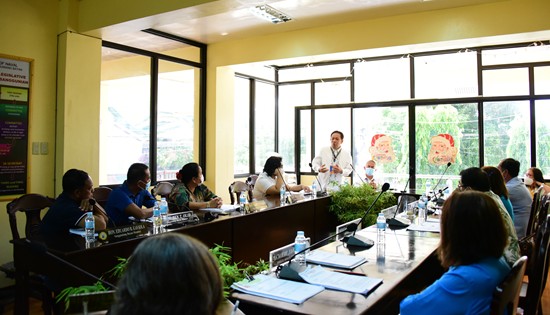
By
DPWH Biliran
November 18, 2020
NAVAL, Biliran – To
address the recurring problem on the Caraycaray and Catmon Bridge
Detours in Naval town, the Naval Local Legislative Members and the
Department of Public Works and Highways- Biliran District
Engineering Office (DPWH-BDEO) joined hand in hand to find solution
for the problem.
During the 59th Regular
Sangguniang Bayan (SB) Session of the Local Legislative Members on
November 16, 2020 at SB Session Hall, David P. Adongay Jr., District
Engineer (DE) and Alfredo L. Bollido, Assistant District Engineer (ADE)
clarify and explain some issues regarding the controversial bridges
and detours in Naval, Biliran.
Recently, the Catmon and
Caraycaray Bridge Detours became unpassable to the travelling public
due to the continuous heavy rains brought by subsequent typhoons:
Rolly (October 25, 2020) and Ulysses (November 10, 2020) that caused
the water to overflow which resulted to erosion of the bridge
detours.
To prevent or minimize the
situation of the said detours, Hon. Eduardo B. Gaviola, SB Member
suggested to DPWH thru DE Adongay to improve the roadway of the
Catmon Bridge detour by concreting it, similar to the detour of
Caraycaray Bridge. Gaviola also suggested to conduct a rechanneling
on the Catmon and Caraycaray rivers.
Citing the construction/
widening of the Anas Bridge project, Gaviola said that the bridge
was no longer inundated as it used to, after the said project was
completed. In his assumption, because the aggregates used during the
construction of the said project was taken from Anas River, it makes
the river deeper and wider, thus less likely for water to overflow.
The suggestion was
supported by Hon. Ben T. Olid, SB Member. He added that if
rechanneling would be done, quarried materials should be taken away
or be placed at the back of the flood control where it cannot return
to the river.
DE Adongay explained that
the district office has already submitted a request for funding, not
for rechanneling but for dredging of all rivers in Biliran right
after typhoon Urduja in 2017.
However, Adongay said that
there was no action taken regarding this request. The District
Engineer suggested to the Local Legislative to conduct a topographic
survey in coordination with the Department of Environment and
Natural Resources (DENR) to determine the portion of the river
channel where dredging/ rechanneling has to be undertaken. He
suggested the SB Members to pass a resolution through the
Congressman of the Lone District of Biliran requesting the DPWH for
funding of the project.
On the status of the
construction/ replacement of Caraycaray Bridge currently being
implemented by the DPWH Regional Office VIII, the District Engineer
reported that the delay has remained caused by the unavailability of
required pile integrity and dynamic strain tests, since accredited
companies (geotechnical firms) from Manila and Cebu are still
affected with travel restrictions due to the prevailing pandemic.
According to Adongay, the
said construction tests are part of the construction process and a
requirement. He explained that the absence of the said tests will
affect the bridge construction process which will result in
variation order and additional expenses. The said tests are also
needed for the Construction/ Replacement of the Catmon Bridge.
Hon. Marietta C. Ebio, SB
Member clarified that workers who are doing projects in the Province
are no longer required to undergo quarantine as long as they will
coordinate with the LGU. According to Hon. Ebio, workers can
immediately report to their work assignments as long as they will
just be in one place for the whole stay.
During the session, some
issues were also brought up concerning DPWH infrastructure projects.
The meeting concluded with
DE Adongay assuring that the suggestions/ recommendations taken
during the meeting be brought to the attention of the DPWH Regional
Office for action.
A closer look of
Farm-to-market road in Barangays Imelda to Avelino

By
GISSELLE G. PARUNGAO
November 17, 2020
CALBAYOG CITY –
Farm-to-market roads (FMRs) constructed from the fund allotted by
the Department of Agriculture paved the way for the concreting of
FMR in Barangays Imelda through Bana-o to Avelino located in the
Municipality of Sta. Margarita, Samar with a total allocation of P50
million.
A concreted road which
spans 900 meters is constructed on most part of Barangay Imelda. The
rest is an opening with a length of 1.780 kilometers. With a width
of 5.3 meters, a riprap was also infused in the project to avoid
collapse of structure and protect soil from erosion since the
structure is located in the mountains.
Copra, rice, banana, corn
and other root crops such as taro, cassava and sweet potato are
products that are usually being delivered to the local markets in
Calbayog City from the said barangays.
Residents and farmers
alike, who are living in Barangays Imelda, Bana-o and Avelino would
have to walk for 3-4 hours on foot on a footpath to reach Barangay
Napuro and from there, they will need to ride a motor vehicle to
reach the city proper for another 30 minutes. Income is strenuous
for farmers since they need to bribe someone depending on the
product that they are selling aside from the fare that they pay for
the motor vehicle from Barangay Napuro to the city proper.
A resident and farmer of
Barangay Bana-ao, DayDay Tolibat have these to say. “Amon la
ginkakarga amon produkto pareho san saging o kopra sa amon
kalugaringon na lawas tapos mano-mano la ngadto sa dalan tapos pag
abot namon sa Napuro, gnsasakay na namon ngadto sa Calbayog. Tikang
sa Bana-o maglalakat kami sa Napuro tapos sa Napuro karga na namon
tikadto sa Calbayog na. Naglalakat kami danay upat ka oras, naabot
lima, danay tulo liwat depende la san imo kalakat ngadto. Wara pa
dida an tikang sa Napuro tikadto sa Calbayog. (We carry our own
products in our backs like bananas or copra and trudge the footpath
to Barangay Napuro, then we load it on a motor vehicle that passes
the said barangay to the city proper. We walk for four hours,
sometimes five or three depending on our pace, excluding the
time-travel from Barangay Napuro to the city proper.)
A resident and Barangay
Captain of Barangay Imelda attested saying, “mahirap talaga noon na
hindi pa kalsada ang aming barangay dahil sa mga produkto na lang na
aming dinadala papunta sa car line dahil upland itong aming lugar,
mahirap talaga. Kung mayroon kaming produktong copra na dinadala
namin sa Napuro, galing dito, ang pagdala, binubuhat lang ng tao at
yan ay kada sako binigbyan ng suhol ng seven pesos kada kilo o five
pesos depende sa presyo ng kopra. Kaya sobrang hirap na wala pang
kalsada noon”. (When the road is non-existent, it is so hard for us
to deliver our goods to where motor vehicles are available because
we come from an upland. If we have products to send to the market,
we need to go walk on foot and load it on a make-shift basket
carried at the back to Barangay Napuro and bribe them with seven or
five pesos per kilo depending on the price of copra. That is why it
is hard when there is no road.)
With the completion of
this farm-to-market road, farmers’ income is much better since
travel of their goods are directly delivered to the public markets.
Travel time was reduced from 15-10 minutes to Barangay Napuro where
they can get ahold of vehicles to Calbayog City. Farmers won’t have
to bribe just to get their products to the local markets since
public transportations can now reach their barangays because of the
completed roads.
Furthermore, health issues
such as problems in carrying their sick or those who are pregnant,
can now be transported to the nearest hospitals immediately unlike
before that that they have to carry them and travel on foot for
hours.
“Pag-abot naman san mga
may sakit amon la iton ginkakarga ngadto kay wara man natukad ngadi
sa amon nga ma check-up. Tapos kun may mga burod, nanganganak, amon
iton gnbababa liwat, lakat na liwat. Pag abot sa Napuro mao na
masakay ngadto sa Calbayog, Pero yana madali na kay didi na la
masakay deretso na an byahe kay may ada na man sarakyan”, said Mr
Tolibat. (when it comes to those who are sick and pregnant, we carry
them in our backs since no one can come here for check-ups. But now,
it is easier since any vehicle can now reach our place.)
In the communities where
the primary source of livelihood is farming, the concrete road is a
welcome respite from the inconvenience of travelling to the
Poblacion and back, and able to get their produce to the market
cheaper and faster.
Farmers have better
opportunities ahead of them now. Basic infrastructure paves the way
for a future that holds an abundance of promise, heightened
productivity and accessibility.